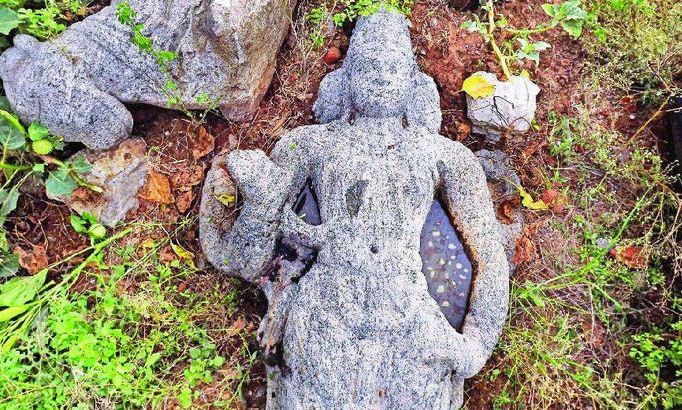
without informing the Archeological Survey of India or the state
archaeology department [Credit: The Times of India]
Today, the construction of the temple is almost over. But the new structure has taken over the place where the rare sculptures were kept. As a result, a broken shiva linga, a moss-covered Somaskanda panel and many more sculptures are scattered around the temple, covered by grass and almost lost. Heritage activists say the committee members of the temple shifted all the sculptures without informing the Archeological Survey of India or the state archaeology department.
"When I first visited the site six years ago, I could see all sculptures in proper form. But today they have been removed from their original place and lie scattered near the newly constructed temple. They are in ruins," said P Rajasekar, a heritage activist, who recently visited the place and photographed the ruined sculptures.
Aravind Venkatraman, who has so far photographed and documented 200 Chola temples, said the site with ancient Pallava sculptures was discovered in the 1990s. "I have seen the photograph of this ancient Pallava site taken in 2008 at the library of the French Institute of Pondicherry. Some other pictures also show the site with all the sculptures intact," he said.
A committee member of the temple said it was while constructing the temple they removed all the structures and housed them inside a shed. But as the work of the temple progressed, the shed was demolished. Apparently, no one was interested in taking care of the sculptures and they were thrown out. "When we asked the committee members said they would place the sculptures permanently inside a hall adjacent to the temple. But they are not sure when they are going to do this. They are not aware of the heritage value associated with the sculptures," said Venkatraman.
The ruined sculptures, according to Rajasekar, are special in many ways. "There is a beautiful panel of Somaskanda, a form of representation of Shiva with his consort Uma and Skanda on his left. In this panel, you can see Uma and Skanda seated on his right. It's a rare site. There are some inscriptions in 'Vatteluthu'. But the people in the village don't know the value of these sculptures," said Rajasekar.
Apparently, no one has informed the ASI or the state archeological department before shifting these heritage structures. "The sculptures are in bad shape. It's high time either the ASI or the state archaeology department took up the issue. Otherwise, we will lose these ancients pieces of art soon," he said.
Author: M. T. Saju | Source: The Times of India [April 30, 2015]